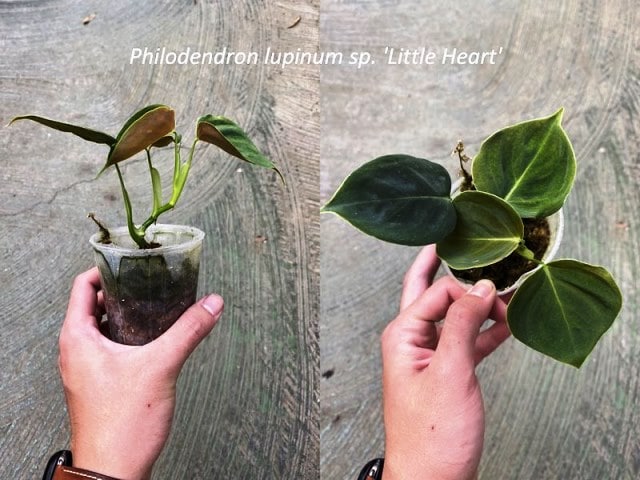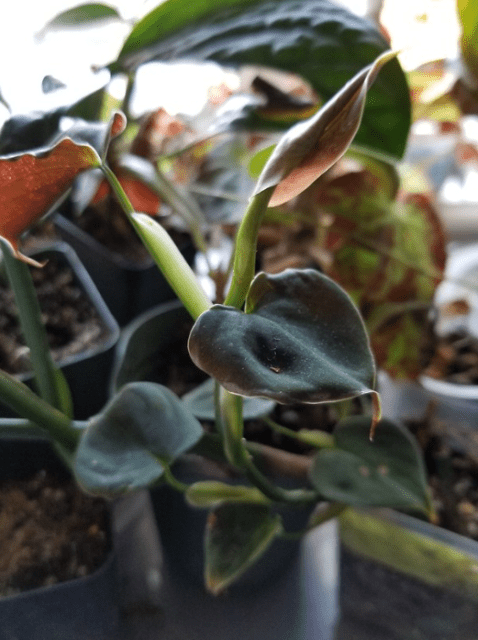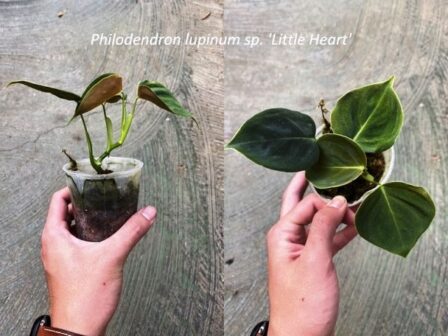If you are a plant enthusiast, you must always seek a new plant for your place or the garden. Today we will discuss one such plant with dynamic nature and fantastic adaptation. Philodendron lupinum is the plant we are talking about. The plant is rare to find and is heavy on the pockets as well. The plant is known for its beauty and attractiveness. It is quite easy to take care of this plant, making it one of the most sought plants in the market.
The price is vindicated due to its rarity and leaves that grow into a glossy texture from velvet as the vine matures. If you want to get one for your place and learn how to take care of this little plant, you have landed on the right page. In this post, we will discuss the plant and share some insights into caring for it.
About Philodendron lupinum
The Philodendron plant was discovered in 2008 in the Amazonian rainforest in Acre. After 15 years of its discovery, the plant is only found here. It makes the plant rarer, which propels its price in the market. The plant sends the vines to the roots present in the soil.
The plant is in demand due to its spectacular leaves that change as it matures. Despite coming from an exotic origin, growing the plant is not an uphill task. Even if you have never grown a plant or are just starting with it, you will need to follow some easy steps to get the rare plant to grow.
Philodendron lupinum is a hemiepiphyte and comes under the plant family of Araceae. Before the plant focuses on getting its roots into the soil, it spends its initial life building the canopy. The leaves of the plant grow 5-6 times bigger than in their early stage of life. The plant grows toward the light, and the climbing ability of the plant is responsible for this phenomenon.
Will DIY work for the care of plants?
Taking care of Philodendron lupinum can be done independently, as it is a simple process. Hiring a professional is not prudent as it will burden your pocket. Though the professional will take better care of the plant, following some simple steps can achieve the same result. So, DIY will work fine if you want to grow and take care of Philodendron lupinum.

Benefits of Philodendron lupinum
Philodendron lupinum comes with the following benefits.
- Air purifier
Pollution is prevalent across the globe, and air purifiers have become the need of the hour to keep our respiratory system healthy. Rather than installing an air purifier machine, one can opt for the Philodendron lupinum plant as a natural cleaner. Scientists have corroborated that this plant effectively purifies polluted and contaminated air and ensures that residents inhale purified air.
- Stress buster
Due to competitive and hectic life schedules, stress is a part of everyone’s life. But plants can help us to reduce our stress levels and feel relaxed. Studies have shown that taking care of a plant can reduce the stress level of a being and elevate its mood. Reducing stress has ample benefits for human health. The low-stress level also improves sleep quality and makes an individual feel fresh and energetic. Productivity can also boost by having a Philodendron lupinum plant, as it reduces stress levels and increases focus due to quality sleep.
- Adorn the place
Only a few plants can match the beauty of the Philodendron lupinum plant. Their leaves are captivating and are perfectly capable of adorning the room. You can use them as a centerpiece in your hall to enhance the beauty of the place.
- Low maintenance
The maintenance cost of this plant is very low. Hence, it does not put a burden on your pocket. Without much complexity, one can take care of the plant. The maintenance process might look complex, but it is easy as it seems.
- Propagation is easy
Propagating a Philodendron lupinum is easy, and one can get multiple plants from one plant. It is done through stem cutting which we will discuss later in the article. Location is also not a big problem, as this plant thrives in most localities.
The plant has several other health benefits facilitating a person’s lifestyle and does not dent the pockets. It is a plant that yields high results on low investment. The plant takes little time to care for and still reaps high rewards. Getting one at your place can significantly change your life.
Factors affecting the growth and care of Philodendron lupinum
Various factors affect the plant’s growth, which should be taken care of while nurturing a Philodendron lupinum. Some crucial factors are soil type, temperature, light, etc. Do not worry if you have yet to learn about these factors. We will discuss every one of them in detail to help the owner take care of their plant most effectively.
Care of Philodendron lupinum
- Watering
Watering a plant is one of the most crucial factors affecting its growth and sustainability. Every plant is different and asks for different treatments. Hence, knowing the right way to water your plant is important. Philodendron lupinum is discovered in a rainforest where the climatic conditions are quite dry, especially in winter. The Amazonian rainforest rains once a week during the winter season. But there is a contrast between summer and winter. During the summer season, it rains relatively more than average. Hence, it is important to water the plant accordingly. Water them more in the summer than in the winter. In the spring season, use lukewarm water and slowly pour it on the soil.
· Light
The Amazon rainforest is exposed to the equator sunlight, which is quite bright. But Philodendron lupinum is sheltered under the tree canopy at its initial life stage. It means the plant is not exposed to direct sunlight in its initial stages. The light requirement of this plant is not much, and an indirect light between medium to bright will be enough for it to propel.
A north or east window would easily cater to the plant’s needs. However, a south or west-facing window will not be suited for its growth, as its leaves can get damaged. Though its capacity to grow in the shade is more than any other philodendrons, the shade will hamper its growth.
· Temperature and Humidity
Philodendron lupinum thrives in warm and humid conditions. Keep the plant in a room with a temperature range between 60-85°F (16-29°C). Low humidity levels cause the leaves to turn brown and curl up, so it’s essential to maintain a humidity level of 50% or higher. You can increase the humidity levels with the help of a humidifier near the plant, grouping plants, or placing a tray of water nearby.
· Soil
Philodendron lupinum requires well-draining soil that is rich in organic matter. Use a high-quality potting mix containing peat moss, perlite, and vermiculite, which provides the necessary nutrients and allows excess water to drain away from the roots. Avoid using heavy soil that retains moisture, leading to root rot and other problems.
· Fertilizer
Philodendron lupinum requires regular feeding to promote growth and development. Apply a balanced liquid fertilizer every two weeks during the growing season (spring and summer), and reduce the frequency during the dormant season (fall and winter). Avoid over-fertilizing, as it can lead to salt build-up and damage the roots.
· Pruning
Philodendron lupinum requires occasional pruning to maintain its shape and promote bushy growth. Use sharp pruning shears or scissors to remove dead or damaged leaves, stems, and flowers. Pinch off the stem tips to encourage branching and fuller growth.
· Pests
Philodendron lupinum is susceptible to a few pests and diseases, but they are relatively easy to control with proper care and maintenance. You can eliminate them with insecticidal soap or neem oil. You can prevent fungal diseases like root rot and leaf spot by avoiding overwatering, providing adequate air circulation, and keeping the foliage dry.
Problems with Philodendron lupinum
Though Philodendron lupinum has several benefits, it also has some problems. The problems could be more substantial and can easily be taken care of. Some mistakes made by the caretaker cause all these problems. Some of the common problems are:
· Yellowing Leaves
One of the most common problems with Philodendron lupinum is yellowing leaves. It can occur due to overwatering, underwatering, or exposure to direct sunlight. It is essential to identify the underlying cause to address this issue. If the soil is too wet, reduce watering frequency and ensure the pot has proper drainage. If the soil is too dry, increase the watering frequency and provide adequate moisture. If the plant encounters direct sunlight, move it to a shadier spot or provide filtered light.
· Brown Tips
Brown tips on the leaves can be due to several factors, including low humidity levels, underwatering, or over-fertilizing. To address this issue, increase the humidity levels with a humidifier near the plant or group plants. Ensure the soil is moist but not overwatered, and reduce fertilization frequency to prevent salt build-up.
· Root Rotting
Root rotting is a fungal disease due to overwatering and poor drainage. To address this issue, remove the affected plant from the pot, cut away the damaged roots, and repot it in fresh soil with adequate drainage. Ensure the pot has drainage holes and avoid overwatering in the future.
· Disease
Another problem that can be caused by overwatering the plant is a fungal disease. Fungal diseases can ruin the leaves and kill them. You must cut and replant the affected parts to regrow them again.
These were some problems associated with the Philodendron lupinum. But, all these problems are caused by needing to follow the care process diligently. Overwatering is the most common reason for plants getting ruined. So, ensure to water them correctly, and if any symptoms become evident, immediately take action to prevent further damage. You can also seek the help of an experienced gardener if you think the situation is beyond your control.

Propagation of Philodendron lupinum
Philodendron lupinum is very adaptive. Hence, they easily adapt to the soil, leading to new growth in less time. So, this plant is perfect for one willing to multiply them. Following are some guidelines to propagate Philodendron lupinum.
- It is crucial to choose a healthy branch for the healthy growth of the plant. An old branch is not recommended for propagation, and the branch should be free from pests.
- The removed or cut part should entail one leaf and one node. The size does not matter, you can cut as much as you want, but the cut portion should be at most 30% of the primary or original plant.
- If you are cutting multiple one-leaf and one node, make sure that branch is cut into appropriate pieces, the node is pristine, and the leaf is attached to it. If you are cutting a longer branch, remove the cutting of the bottom leaves to disclose the node.
- When you put the cutting into the water, the node should be completely submerged. Cover up the node completely by wrapping it up in sphagnum moss if propagating in sphagnum.
- Wait for the roots to grow a couple of inches long and become well-developed.
- Now you have two options. Either of the options will work well and with the same effectiveness. Either keep the cutting in sphagnum moss or again put the cutting in a pot with fresh soil.
- The above tips diligently will yield the desired result of easily multiplying the plants through propagation. In four weeks, the result of the propagation and proliferation will be evident to the eyes, and after that, the plants will thrive rapidly in numbers.
Final words
These were some tips and tricks to propagate and care for Philodendron lupinum. Putting a little effort into growing the plant will reap various benefits for your residence. This plant has many advantages, and it does not require much effort to grow. All one needs to do is take care of some factors and get the desired result. So, if you have now understood the intricacy of this plant and what it takes to grow one or multiple in your home, it is time to visit a nursery and get one for your home. The plant costs little and will not burden your pocket in the future.
Sources:

